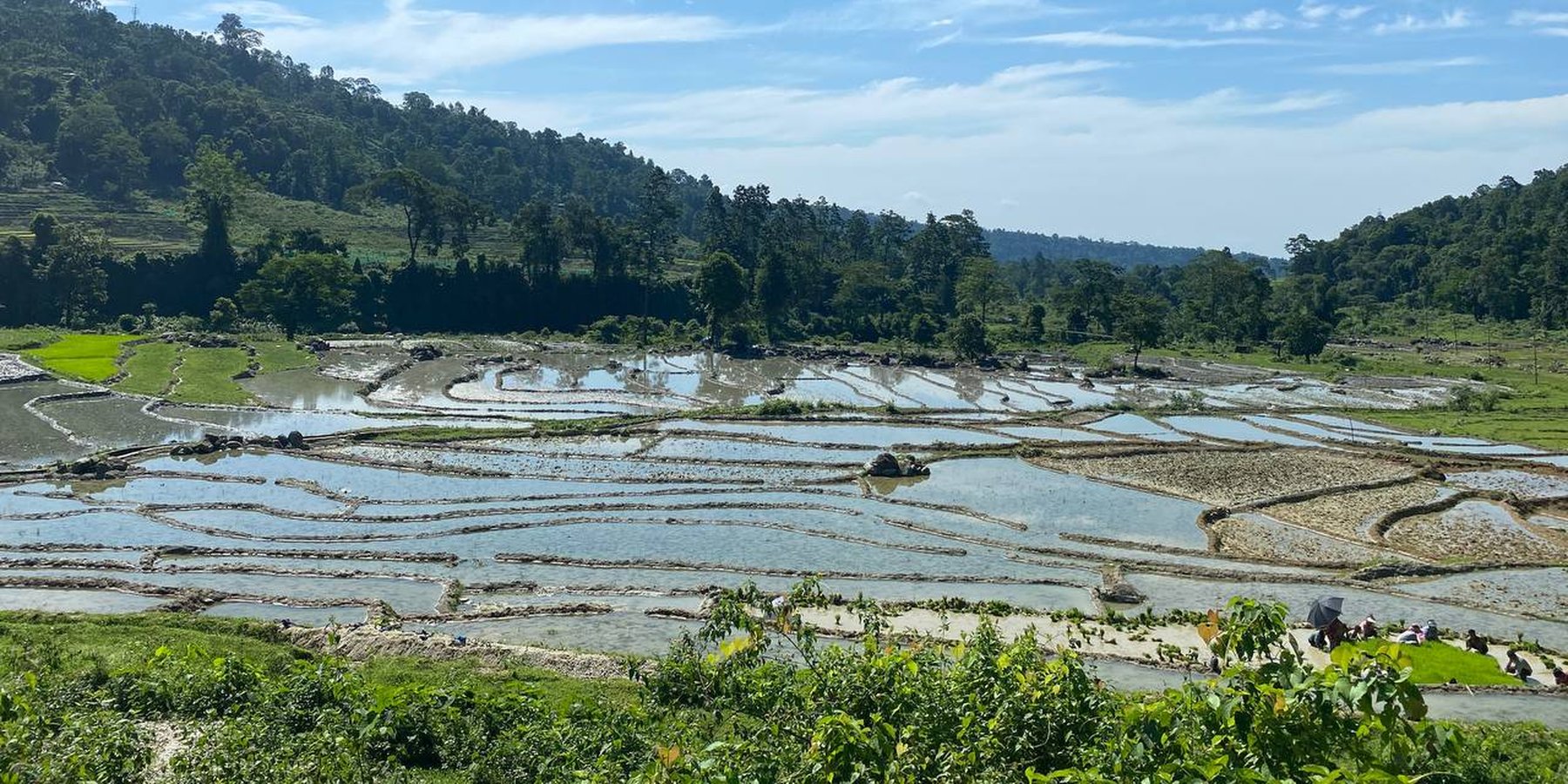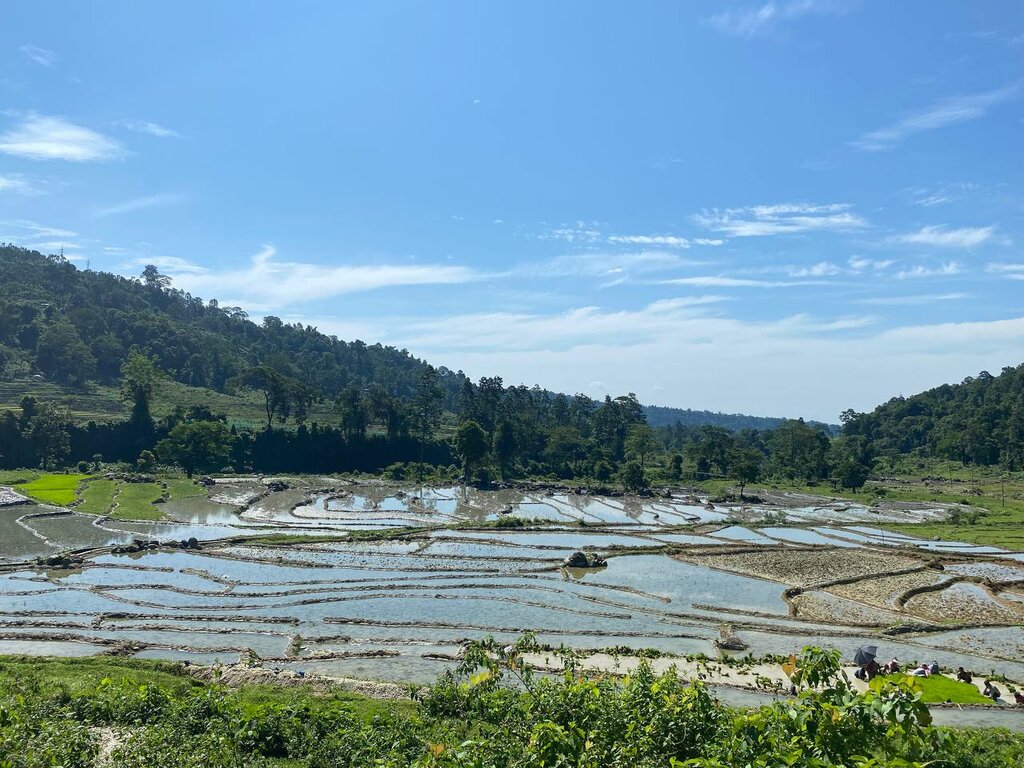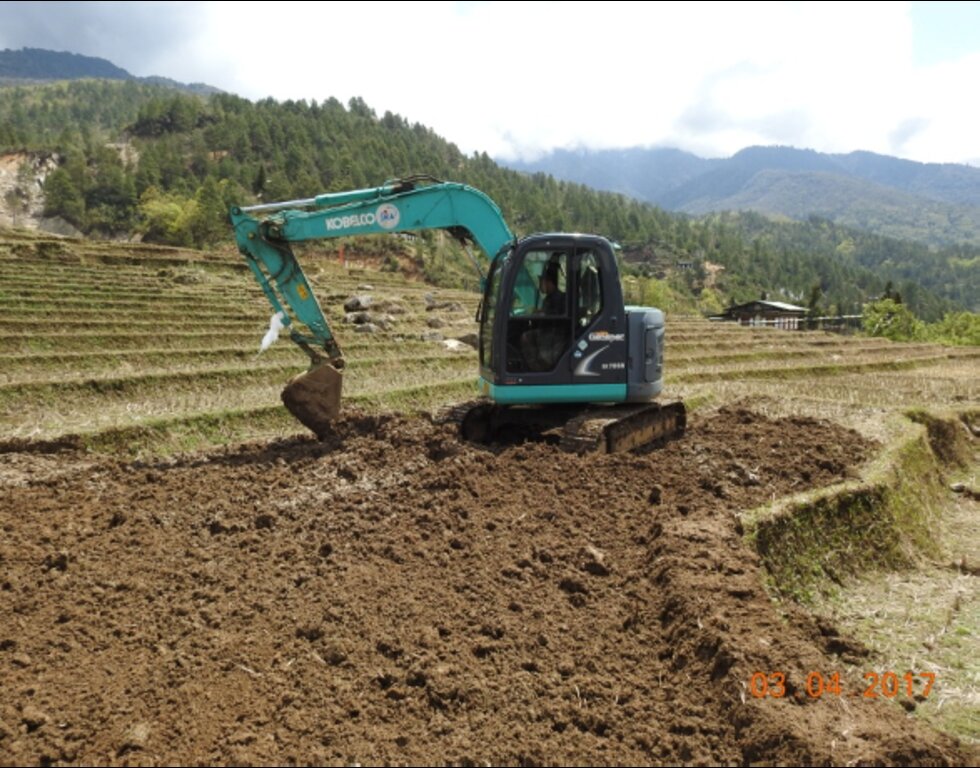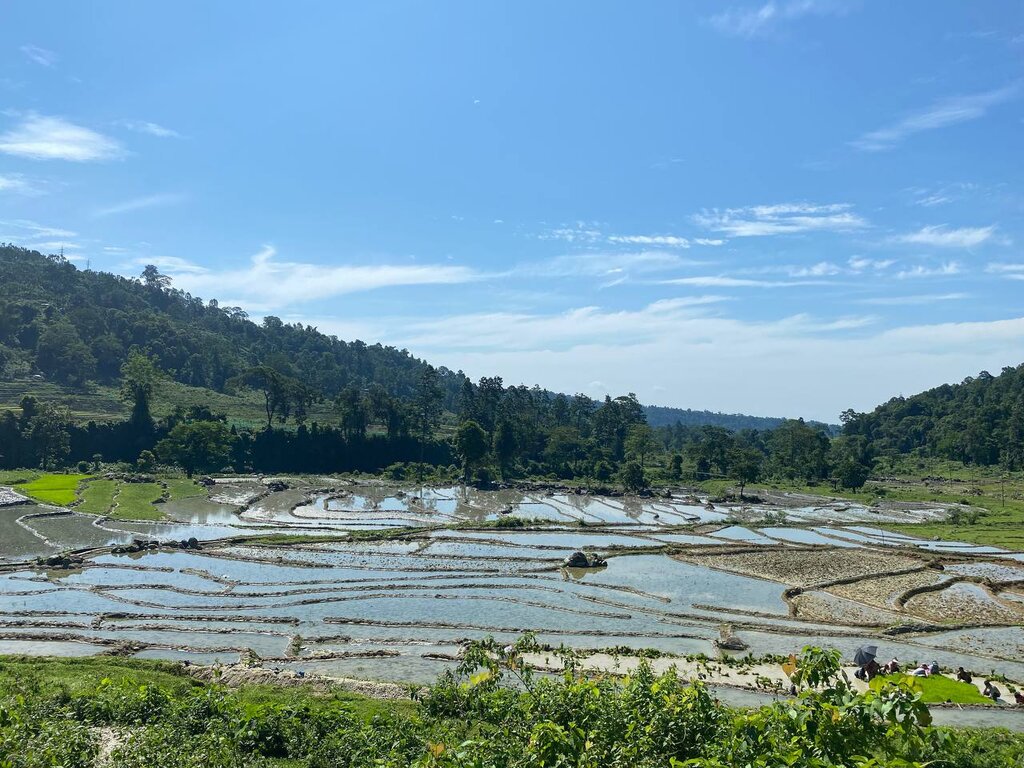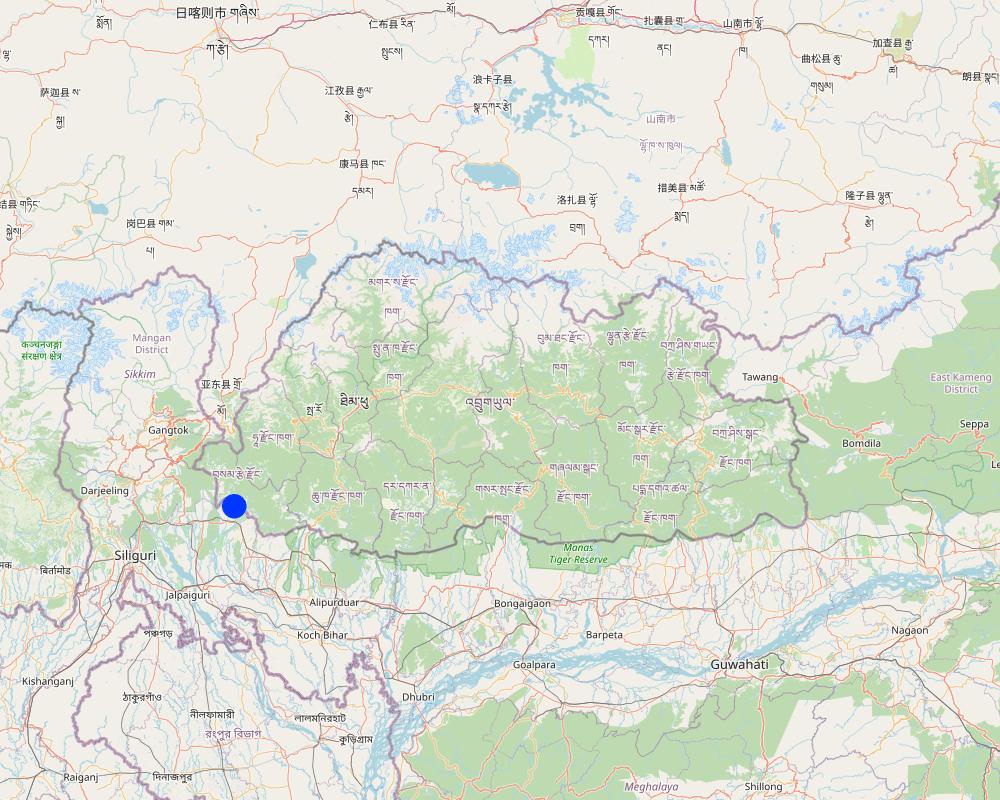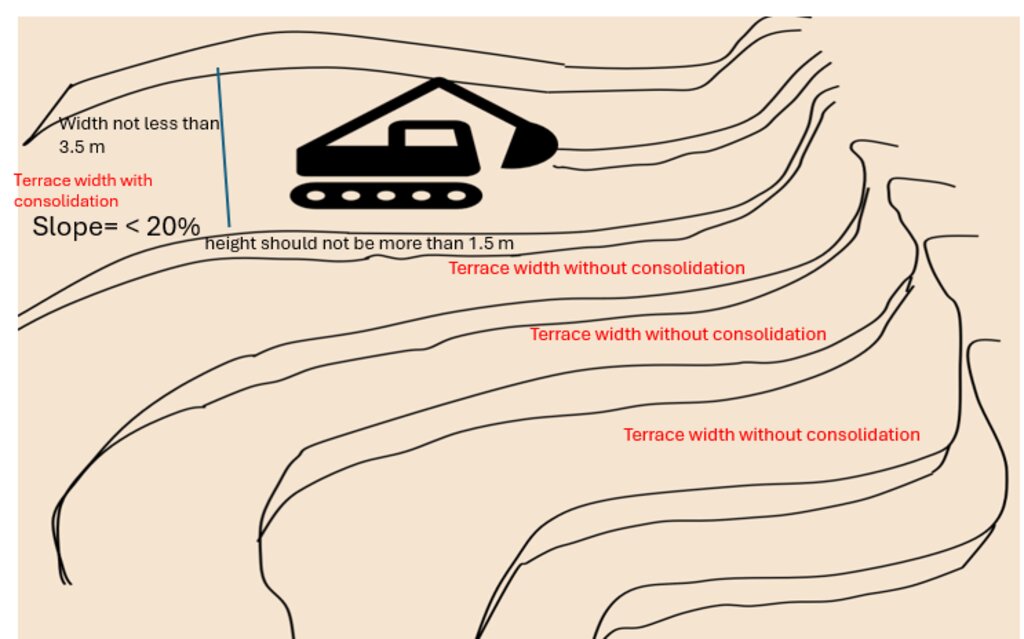Terrace Consolidation by Machine [ภูฏาน]
- ผู้สร้างสรรค์:
- การอัพเดท:
- ผู้รวบรวม: Karma Wangdi
- ผู้เรียบเรียง: Tashi Wangdi
- ผู้ตรวจสอบ: William Critchley, Rima Mekdaschi Studer
Aari Jakaed Tangni (ཨ་རི་བརྒྱ་བསྐྱེད་བཏང་ནི)
technologies_6871 - ภูฏาน
ดูส่วนย่อย
ขยายทั้งหมด ย่อทั้งหมด1. ข้อมูลทั่วไป
1.2 รายละเอียดที่ติดต่อได้ของผู้รวบรวมและองค์กรที่เกี่ยวข้องในการประเมินและการจัดเตรียมทำเอกสารของเทคโนโลยี
วิทยากรหลัก
ผู้ใช้ที่ดิน:
Limbu Ram Bahadur
Sang-Ngag-Chhoeling village, Yoeseltse Gewog (Block), Samtse Dzongkhag (District)
ภูฏาน
ชื่อของโครงการซึ่งอำนวยความสะดวกในการทำเอกสารหรือการประเมินเทคโนโลยี (ถ้าเกี่ยวข้อง)
Strengthening national-level institutional and professional capacities of country Parties towards enhanced UNCCD monitoring and reporting – GEF 7 EA Umbrella II (GEF 7 UNCCD Enabling Activities_Umbrella II)ชื่อขององค์กรซึ่งอำนวยความสะดวกในการทำเอกสารหรือการประเมินเทคโนโลยี (ถ้าเกี่ยวข้อง)
National Soil Services Centre, Department of Agriculture, Ministry of Agriculture & Livestock (NSSC) - ภูฏาน1.3 เงื่อนไขการใช้ข้อมูลที่ได้บันทึกผ่านทาง WOCAT
ผู้รวบรวมและวิทยากรหลักยอมรับเงื่อนไขเกี่ยวกับการใช้ข้อมูลที่ถูกบันทึกผ่านทาง WOCAT:
ใช่
1.4 การเปิดเผยเรื่องความยั่งยืนของเทคโนโลยีที่ได้อธิบายไว้
เทคโนโลยีที่ได้อธิบายไว้นี้เป็นปัญหาของความเสื่อมโทรมโทรมของที่ดินหรือไม่ จึงไม่ได้รับการยอมรับว่าเป็นเทคโนโลยีเพื่อการจัดการที่ดินอย่างยั่งยืน:
ไม่ใช่
แสดงความคิดเห็น:
This technology is one of the major land degradation mitigating measures
2. การอธิบายลักษณะของเทคโนโลยี SLM
2.1 การอธิบายแบบสั้น ๆ ของเทคโนโลยี
คำจำกัดความของเทคโนโลยี:
Terrace consolidation is the merging of existing narrow bench terraces into larger terraces to enable farm mechanization, commercial farming and crop intensification. This technology is promoted as the existing terraces are generally narrow and this limits efficient operation and utilization of land and other resources.
2.2 การอธิบายแบบละเอียดของเทคโนโลยี
คำอธิบาย:
Terrace consolidation involves merging of small terraces into larger terraces using a machine to make more efficient use of land through farm mechanization, commercial farming and crop intensification. This technology is promoted as the existing terraces are generally narrow and this limits efficient operation and utilization of land and other resources.
The consolidation of narrow terraces is recommended if the general slope of the proposed site is less than 20° (36%) with good soil drainage and low risk of land degradation. While consolidating narrow terraces, it is strongly recommended to remove the topsoil from the terraces and put it back once the levelling is completed. The consolidated terrace should maintain a maximum riser height of 1.5 m and bed width of 3.5 m. For slopes below 12° (21%), the bench width should not exceed 5–6 m.
Farmers can expand the amount of arable land available, maximize agricultural operations, and encourage sustainable farming methods for higher crop output and enhanced ecological resilience by converting narrower and more steep bench terraces into bigger ones (NSSC, 2020). A large portion of hillside farmers around the world rely on terracing. For the purpose of facilitating the growth of field crops, horticultural crops, fodder, and other crops that require specific management practices (e.g., irrigation), alone or in agroforestry systems, hilly or mountainous terrains are divided into narrow but graduated steps, typically 2-3 m wide and 50-80 m long across the slopes (Chapagain & Raizada, 2017).
Enlargement of terraces begins with a thorough survey and analysis of the topography and terrain. In order to build larger terraces with the least amount of environmental damage, this phase is essential. The next step in the construction process is to reshape the present, small terraces into larger, more open ones. To make wider terraced levels, this may entail moving soil and cutting through slopes. Furthermore, filling up the gaps and levelling the land's surface is required in order to reduce the number of risers and produce a continuous, gently sloping terrace. The installation of suitable drainage systems is also crucial to guarantee adequate water management and stop soil erosion.
Larger terraces enhance water management capabilities. With a more extensive surface area, water runoff is minimized, and the distribution of irrigation water becomes more even, promoting better soil moisture retention and reducing erosion. This, in turn, contributes to soil health and fertility, supporting sustainable farming practices. Moreover, the consolidation of smaller terraces into larger ones reduces the overall number of risers, thereby enhancing accessibility for farmworkers and farm machinery. This ease of access further optimizes the use of resources and fosters better crop management. Additionally, larger terraces can enable the implementation of crop diversification strategies, such as intercropping and crop rotation, promoting biodiversity and mitigating the risk of crop failure due to pests or adverse weather conditions.
However, the process of enlarging terraces involves altering the terrain, which can lead to soil erosion, habitat destruction, and ecological imbalances. This environmental impact may negatively affect local flora and fauna, reducing biodiversity and disrupting the delicate ecological equilibrium (Deng et al., 2021). Planning for safe discharge of excess water out of the terrace system effectively helps preserve soil fertility and reduces runoff. It is essential also to pay close attention to the preservation of the local ecosystem and biodiversity throughout the process.
2.3 รูปภาพของเทคโนโลยี
2.5 ประเทศภูมิภาค หรือสถานที่ตั้งที่เทคโนโลยีได้นำไปใช้และได้รับการครอบคลุมโดยการประเมินนี้
ประเทศ:
ภูฏาน
ภูมิภาค/รัฐ/จังหวัด:
Samtse
ข้อมูลจำเพาะเพิ่มเติมของสถานที่ตั้ง :
Sang-Ngag-Chhoeling
ระบุการกระจายตัวของเทคโนโลยี:
- กระจายไปอย่างสม่ำเสมอในพื้นที่
If precise area is not known, indicate approximate area covered:
- < 0.1 ตร.กม.(10 เฮกตาร์)
Is/are the technology site(s) located in a permanently protected area?
ไม่ใช่
แสดงความคิดเห็น:
Total area is 6 hectares
Map
×2.6 วันที่การดำเนินการ
ระบุปีที่ใช้:
2021
2.7 คำแนะนำของเทคโนโลยี
ให้ระบุว่าเทคโนโลยีถูกแนะนำเข้ามาอย่างไร:
- ทางโครงการหรือจากภายนอก
ความคิดเห็น (ประเภทของโครงการ เป็นต้น) :
The terrace consolidation activities in this community was funded by the Green Climate Fund (GCF) project for Land Consolidation
3. การจัดประเภทของเทคโนโลยี SLM
3.1 วัตถุประสงค์หลักของเทคโนโลยี
- ปรับปรุงการผลิตให้ดีขึ้น
- ลด ป้องกัน ฟื้นฟู การเสื่อมโทรมของที่ดิน
- ปรับตัวเข้ากับการเปลี่ยนแปลงภูมิอากาศของโลก สภาพภูมิอากาศที่รุนแรงและผลกระทบ
- ชะลอการเปลี่ยนแปลงภูมิอากาศของโลกและผลกระทบ
- สร้างผลกระทบทางด้านเศรษฐกิจที่เป็นประโยชน์
3.2 ประเภทของการใช้ที่ดินในปัจจุบันที่ได้นำเทคโนโลยีไปใช้
Land use mixed within the same land unit:
ไม่ใช่

พื้นที่ปลูกพืช
- paddy
จำนวนของฤดูเพาะปลูกต่อปี:
- 1
Is intercropping practiced?
ไม่ใช่
Is crop rotation practiced?
ไม่ใช่
3.3 Has land use changed due to the implementation of the Technology?
Has land use changed due to the implementation of the Technology?
- No (Continue with question 3.4)
Land use mixed within the same land unit:
ไม่ใช่

พื้นที่ปลูกพืช
- paddy
Is intercropping practiced?
ไม่ใช่
Is crop rotation practiced?
ไม่ใช่

การตั้งถิ่นฐาน โครงสร้างพื้นฐาน
- การตั้งถิ่นฐาน ตึกอาคาร
- การจราจร ทางถนน รถไฟ
- พลังงาน ท่อส่งก๊าซธรรมชาติ สายส่งไฟฟ้า

ที่ดินที่ไม่ให้ผลผลิต
3.4 การใช้น้ำ
การใช้น้ำของที่ดินที่มีการใช้เทคโนโลยีอยู่:
- น้ำฝนร่วมกับการชลประทาน
3.5 กลุ่ม SLM ที่ตรงกับเทคโนโลยีนี้
- มาตรการปลูกพืชขวางความลาดชัน (cross-slope measure)
- การป้องกัน / การจัดการพื้นที่ชุ่มน้ำ
- การลดความเสี่ยงจากภัยพิบัติบนพื้นฐานของระบบนิเวศ
3.6 มาตรการ SLM ที่ประกอบกันเป็นเทคโนโลยี

มาตรการอนุรักษ์ด้วยโครงสร้าง
- S1: คันดิน
- S2: ทำนบ เขื่อนดิน
3.7 รูปแบบหลักของการเสื่อมโทรมของที่ดินที่ได้รับการแก้ไขโดยเทคโนโลยี

การกัดกร่อนของดินโดยน้ำ
- Wt (Loss of topsoil): การสูญเสียดินชั้นบนหรือการกัดกร่อนที่ผิวดิน
- Wg (Gully erosion): การกัดกร่อนแบบร่องธารหรือการทำให้เกิดร่องน้ำเซาะ
3.8 การป้องกัน การลดลง หรือการฟื้นฟูความเสื่อมโทรมของที่ดิน
ระบุเป้าหมายของเทคโนโลยีกับความเสื่อมโทรมของที่ดิน:
- ลดความเสื่อมโทรมของดิน
- ปรับตัวกับสภาพความเสื่อมโทรมของที่ดิน
4. ข้อมูลจำเพาะด้านเทคนิค กิจกรรมการนำไปปฏิบัติใช้ ปัจจัยนำเข้า และค่าใช้จ่าย
4.1 แบบแปลนทางเทคนิคของเทคโนโลยี
ข้อมูลจำเพาะด้านเทคนิค (แบบแปลนทางเทคนิคของเทคโนโลยี):
consolidation of old and small terraces with machines
ผู้เขียน:
karma Wangdi
วันที่:
20/07/2023
4.2 ข้อมูลทั่วไปเกี่ยวกับการคำนวณปัจจัยนำเข้าและค่าใช้จ่าย
ให้ระบุว่าค่าใช้จ่ายและปัจจัยนำเข้าได้รับการคำนวณอย่างไร:
- ต่อพื้นที่ที่ใช้เทคโนโลยี
ระบุขนาดและหน่วยพื้นที่:
2.5 acre
If using a local area unit, indicate conversion factor to one hectare (e.g. 1 ha = 2.47 acres): 1 ha =:
1ha
อื่นๆ หรือสกุลเงินประจำชาติ (ระบุ):
Ngultrum
If relevant, indicate exchange rate from USD to local currency (e.g. 1 USD = 79.9 Brazilian Real): 1 USD =:
80.0
ระบุค่าเฉลี่ยของค่าจ้างในการจ้างแรงงานต่อวัน:
500
4.3 กิจกรรมเพื่อการจัดตั้ง
| กิจกรรม | Timing (season) | |
|---|---|---|
| 1. | Secure funding support from GCF | January (Before cropping) |
| 2. | Action planning in consultation with beneficiaries and the stakeholders | February (Before cropping) |
| 3. | Arrangement of excavator machine | First week of March (Before cropping) |
| 4. | Activity implementation | Second week of March till April (Before cropping) |
4.4 ค่าใช้จ่ายของปัจจัยนำเข้าที่จำเป็นสำหรับการจัดตั้ง
| ปัจจัยนำเข้า | หน่วย | ปริมาณ | ค่าใช้จ่ายต่อหน่วย | ค่าใช้จ่ายทั้งหมดต่อปัจจัยนำเข้า | %ของค่าใช้จ่ายที่ก่อให้เกิดขึ้นโดยผู้ใช้ที่ดิน | |
|---|---|---|---|---|---|---|
| แรงงาน | Assisting operator (reaching fuel) | no | 60.0 | 500.0 | 30000.0 | 100.0 |
| แรงงาน | Labelling of terraces | no | 60.0 | 500.0 | 30000.0 | 100.0 |
| อุปกรณ์ | Hiring of Excavator | day | 6.0 | 20000.0 | 120000.0 | |
| ค่าใช้จ่ายทั้งหมดของการจัดตั้งเทคโนโลยี | 180000.0 | |||||
| Total costs for establishment of the Technology in USD | 2250.0 | |||||
ถ้าผู้ใช้ที่ดินรับภาระน้อยกว่า 100% ของค่าใช้จ่าย ให้ระบุว่าใครเป็นผู้รับผิดชอบส่วนที่เหลือ:
This technology is been supported and funded by Green Climate Fund for land consolidation
แสดงความคิดเห็น:
consolidation of old terraces is recommended only if the general slope of the proposed site is less than 20% with good soil drainage and minimal risk of land degradation. While consolidating small terraces into large terraces, the new terrace riser height should not be more than 1.5 m and width of the bench not less than 3.5 .For one ha there are around 34 small terrace which is consolidated to 18 terraces.
4.5 การบำรุงรักษาสภาพหรือกิจกรรมที่เกิดขึ้นเป็นประจำ
แสดงความคิดเห็น:
No maintenance is done until now
4.6 ค่าใช้จ่ายของปัจจัยนำเข้าและกิจกรรมที่เกิดขึ้นเป็นประจำที่ต้องการการบำรุงรักษา (ต่อปี)
แสดงความคิดเห็น:
Till date no maintenance was done
4.7 ปัจจัยสำคัญที่สุดที่มีผลกระทบต่อค่าใช้จ่าย
ปัจจัยสำคัญที่สุดที่มีผลกระทบต่อค่าใช้จ่ายต่างๆ:
The major factor affecting the cost for implementing this technology is in hiring of excavator
5. สิ่งแวดล้อมทางธรรมชาติและของมนุษย์
5.1 ภูมิอากาศ
ฝนประจำปี
- < 250 ม.ม.
- 251-500 ม.ม.
- 501-750 ม.ม.
- 751-1,000 ม.ม.
- 1,001-1,500 ม.ม.
- 1,501-2,000 ม.ม.
- 2,001-3,000 ม.ม.
- 3,001-4,000 ม.ม.
- > 4,000 ม.ม.
ระบุปริมาณน้ำฝนเฉลี่ยรายปี (ถ้ารู้) :หน่วย ม.ม.
1500.00
ข้อมูลจำเพาะ/ความคิดเห็นเรื่องปริมาณน้ำฝน:
The gewog experiences mostly heavy shower with annual rainfall ranging from 1500 mm to 4000 mm
ระบุชื่อของสถานีตรวดวัดอากาศที่ใช้อ้างอิงคือ:
National Center for Hydrology and Metrology (NCHM), Bhutan
เขตภูมิอากาศเกษตร
- กึ่งชุ่มชื้น
Subtropical monsoon climatic zone
5.2 สภาพภูมิประเทศ
ค่าเฉลี่ยความลาดชัน:
- ราบเรียบ (0-2%)
- ลาดที่ไม่ชัน (3-5%)
- ปานกลาง (6-10%)
- เป็นลูกคลื่น (11-15%)
- เป็นเนิน (16-30%)
- ชัน (31-60%)
- ชันมาก (>60%)
ธรณีสัณฐาน:
- ที่ราบสูง/ที่ราบ
- สันเขา
- ไหล่เขา
- ไหล่เนินเขา
- ตีนเนิน
- หุบเขา
ระดับความสูง:
- 0-100 เมตร
- 101-500 เมตร
- 501-1,000 เมตร
- 1,001-1,500 เมตร
- 1,501-2,000 เมตร
- 2,001-2,500 เมตร
- 2,501-3,000 เมตร
- 3,001-4,000 เมตร
- > 4,000 เมตร
ให้ระบุถ้าเทคโนโลยีได้ถูกนำไปใช้:
- ไม่เกี่ยวข้อง
5.3 ดิน
ค่าเฉลี่ยความลึกของดิน:
- ตื้นมาก (0-20 ซ.ม.)
- ตื้น (21-50 ซ.ม.)
- ลึกปานกลาง (51-80 ซ.ม.)
- ลึก (81-120 ซ.ม.)
- ลึกมาก (>120 ซ.ม.)
(ถ้ามี) ให้แนบคำอธิบายเรื่องดินแบบเต็มหรือระบุข้อมูลที่มีอยู่ เช่น ชนิดของดิน ค่า pH ของดินหรือความเป็นกรดของดิน ความสามารถในการแลกเปลี่ยนประจุบวก ไนโตรเจน ความเค็ม เป็นต้น:
Soil Type: Sandy Loam
MC (%): 3.66
OM (%): 1.73
OC (%): 1.00
pH (H20): 6.60
EC (µs/cm): 28.37
N (%): 0.05
P (ppm): 0.73
K (mg/100ml): 82.77
5.4 ความเป็นประโยชน์และคุณภาพของน้ำ
น้ำไหลบ่าที่ผิวดิน:
ดี
คุณภาพน้ำ (ที่ยังไม่ได้บำบัด):
เป็นน้ำเพื่อการดื่มที่ดี
ความเค็มของน้ำเป็นปัญหาหรือไม่:
ไม่ใช่
กำลังเกิดน้ำท่วมในพื้นที่หรือไม่:
ใช่
บ่อยครั้ง:
เป็นครั้งเป็นคราว
5.5 ความหลากหลายทางชีวภาพ
ความหลากหลายทางชนิดพันธุ์:
- ปานกลาง
ความหลากหลายของแหล่งที่อยู่:
- ปานกลาง
5.6 ลักษณะของผู้ใช้ที่ดินที่นำเทคโนโลยีไปปฏิบัติใช้
อยู่กับที่หรือเร่ร่อน:
- อยู่กับที่
แนวทางการตลาดของระบบการผลิต:
- mixed (subsistence/ commercial)
รายได้ที่มาจากนอกฟาร์ม:
- < 10% ของรายได้ทั้งหมด
ระดับของความมั่งคั่งโดยเปรียบเทียบ:
- พอมีพอกิน
เป็นรายบุคคล/ครัวเรือน:
- เป็นรายบุคคล/ครัวเรือน
ระดับของการใช้เครื่องจักรกล:
- งานที่ใช้แรงกาย
- การใช้กำลังจากสัตว์
เพศ:
- หญิง
- ชาย
อายุของผู้ใช้ที่ดิน:
- เด็ก
- ผู้เยาว์
- วัยกลางคน
- ผู้สูงอายุ
5.7 Average area of land used by land users applying the Technology
- < 0.5 เฮกตาร์
- 0.5-1 เฮกตาร์
- 1-2 เฮกตาร์
- 2-5 เฮกตาร์
- 5-15 เฮกตาร์
- 15-50 เฮกตาร์
- 50-100 เฮกตาร์
- 100-500 เฮกตาร์
- 500-1,000 เฮกตาร์
- 1,000-10,000 เฮกตาร์
- >10,000 เฮกตาร์
พิจารณาว่าเป็นขนาดเล็ก กลาง หรือขนาดใหญ่ (ซึ่งอ้างอิงถึงบริบทระดับท้องถิ่น):
- ขนาดกลาง
5.8 กรรมสิทธิ์ในที่ดิน สิทธิในการใช้ที่ดินและสิทธิในการใช้น้ำ
- Family
สิทธิในการใช้ที่ดิน:
- เกี่ยวกับชุมชน (ถูกจัดระเบียบ)
- รายบุคคล
สิทธิในการใช้น้ำ:
- เกี่ยวกับชุมชน (ถูกจัดระเบียบ)
- รายบุคคล
Are land use rights based on a traditional legal system?
ใช่
5.9 การเข้าถึงบริการและโครงสร้างพื้นฐาน
สุขภาพ:
- จน
- ปานกลาง
- ดี
การศึกษา:
- จน
- ปานกลาง
- ดี
ความช่วยเหลือทางด้านเทคนิค:
- จน
- ปานกลาง
- ดี
การจ้างงาน (เช่น ภายนอกฟาร์ม):
- จน
- ปานกลาง
- ดี
ตลาด:
- จน
- ปานกลาง
- ดี
พลังงาน:
- จน
- ปานกลาง
- ดี
ถนนและการขนส่ง:
- จน
- ปานกลาง
- ดี
น้ำดื่มและการสุขาภิบาล:
- จน
- ปานกลาง
- ดี
บริการด้านการเงิน:
- จน
- ปานกลาง
- ดี
6. ผลกระทบและสรุปคำบอกกล่าว
6.1 ผลกระทบในพื้นที่ดำเนินการ (On-site) จากการใช้เทคโนโลยี
ผลกระทบทางด้านเศรษฐกิจและสังคม
การผลิต
การผลิตพืชผล
แสดงความคิดเห็น/ระบุ:
Before the terrace consolidation they used to have minimum production but now they are producing for both self consumption and commercial purpose. these are expert estimates or data measured.
พื้นที่สำหรับการผลิต
แสดงความคิดเห็น/ระบุ:
The merging of small terraces has increased the cropping area. These are expert estimates or data measured.
การจัดการที่ดิน
แสดงความคิดเห็น/ระบุ:
Overall Land management has become easier for them as they can use more machines due to larger flat terraces
ความเป็นประโยชน์และคุณภาพของน้ำ
การมีน้ำไว้ให้สำหรับการชลประทาน
แสดงความคิดเห็น/ระบุ:
The do not have enough water for irrigation during the dry season.
ความต้องการน้ำจากการชลประทาน
แสดงความคิดเห็น/ระบุ:
The land has become larger and they need more irrigation compared to before the terrace consolidation.
รายได้และค่าใช้จ่าย
ค่าใช่จ่ายของปัจจัยการผลิตทางการเกษตร
แสดงความคิดเห็น/ระบุ:
The deployment of number of labor has reduced with the intervention of farm machineries, thus reducing the cost of production with reduced time and man power. These are expert estimates or data measured.
รายได้จากฟาร์ม
แสดงความคิดเห็น/ระบุ:
Farm income has increased compared to past as they have larger area of cultivation.
ความหลากหลายของแหล่งผลิตรายได้
แสดงความคิดเห็น/ระบุ:
The time and resources saved from this technology intervention has been beneficial in for other use. These are expert estimates or data measured.
ภาระงาน
แสดงความคิดเห็น/ระบุ:
Due to mechanized farming favoured by terrace consolidation, the workload at an individual level has significantly reduced. These are expert estimates or data measured.
ผลกระทบด้านสังคมวัฒนธรรมอื่น ๆ
ความมั่นคงด้านอาหาร / พึ่งตนเองได้
แสดงความคิดเห็น/ระบุ:
The increased cropping area and contributed in increase in production, thus enhancing the food and nutrition security. These are expert estimates or data measured.
สถานการณ์ด้านสุขภาพ
แสดงความคิดเห็น/ระบุ:
The better crop productivity is found to be contributing better health quality of the farm household. These are expert estimates or data measured.
SLM หรือความรู้เรื่องความเสื่อมโทรมของที่ดิน
แสดงความคิดเห็น/ระบุ:
Could have better understanding on SLM and its benefits through the sensitization programs. These are expert estimates or data measured.
ผลกระทบด้านนิเวศวิทยา
ดิน
การสูญเสียดิน
แสดงความคิดเห็น/ระบุ:
The flat terraces has been always been adventitious in controlling overall soil and nutrient loss. These are expert estimates or data measured.
การสะสมของดิน
แสดงความคิดเห็น/ระบุ:
Because of very minimum soil loss, the soil accumulation rate in these terraces has been very high. These are expert estimates or data measured.
ลดความเสี่ยงของภัยพิบัติ
ดินถล่ม/ ซากต่าง ๆ ที่ถูกพัดพามา
แสดงความคิดเห็น/ระบุ:
After they have reduce the riser and increased the terrace land there is less risk to landslide when the land becomes stable after the machine work.
6.2 ผลกระทบนอกพื้นที่ดำเนินการ (Off-site) จากการใช้เทคโนโลยี
Specify assessment of off-site impacts (measurements):
there is no off-site impacts recorded for this technology
6.3 การเผชิญและความตอบสนองของเทคโนโลยีต่อการเปลี่ยนแปลงสภาพภูมิอากาศที่ค่อยเป็นค่อยไป และสภาพรุนแรงของภูมิอากาศ / ภัยพิบัติ (ที่รับรู้ได้โดยผู้ใช้ที่ดิน)
การเปลี่ยนแปลงสภาพภูมิอากาศที่ค่อยเป็นค่อยไป
การเปลี่ยนแปลงสภาพภูมิอากาศที่ค่อยเป็นค่อยไป
| ฤดู | increase or decrease | เทคโนโลยีมีวิธีการรับมืออย่างไร | |
|---|---|---|---|
| อุณหภูมิประจำปี | เพิ่มขึ้น | ดีมาก | |
| ฝนประจำปี | ลดลง | ไม่ทราบ |
สภาพรุนแรงของภูมิอากาศ (ภัยพิบัติ)
ภัยพิบัติทางอุตุนิยมวิทยา
| เทคโนโลยีมีวิธีการรับมืออย่างไร | |
|---|---|
| พายุฝนประจำท้องถิ่น | ดีมาก |
| พายุฝนฟ้าคะนองประจำท้องถิ่น | ดีมาก |
| พายุลมประจำท้องถิ่น | ดีมาก |
ภัยพิบัติจากสภาพภูมิอากาศ
| เทคโนโลยีมีวิธีการรับมืออย่างไร | |
|---|---|
| คลื่นความร้อน | ดีมาก |
| คลื่นความหนาว | ดีมาก |
| สภาพอากาศฤดูหนาวที่รุนแรง | ดีมาก |
| ภัยจากฝนแล้ง | ไม่ค่อยดี |
6.4 การวิเคราะห์ค่าใช้จ่ายและผลประโยชน์ที่ได้รับ
ผลประโยชน์ที่ได้รับเปรียบเทียบกับค่าใช้จ่ายในการจัดตั้งเป็นอย่างไร (จากมุมมองของผู้ใช้ที่ดิน)
ผลตอบแทนระยะสั้น:
ด้านบวก
ผลตอบแทนระยะยาว:
ด้านบวก
ผลประโยชน์ที่ได้รับเปรียบเทียบกับค่าใช้จ่ายในการบำรุงรักษาหรือต้นทุนที่เกิดขึ้นซ้ำอีก เป็นอย่างไร (จากมุมมองของผู้ใช้ที่ดิน)
ผลตอบแทนระยะสั้น:
ด้านบวก
ผลตอบแทนระยะยาว:
ด้านบวก
6.5 การปรับตัวของเทคโนโลยี
- 1-10%
ถ้ามีข้อมูลให้บอกปริมาณด้วย (จำนวนของครัวเรือนหรือครอบคลุมพื้นที่):
8 households
Of all those who have adopted the Technology, how many did so spontaneously, i.e. without receiving any material incentives/ payments?
- 0-10%
6.6 การปรับตัว
เทคโนโลยีได้รับการปรับเปลี่ยนเมื่อเร็วๆนี้ เพื่อให้ปรับตัวเข้ากับสภาพที่กำลังเปลี่ยนแปลงหรือไม่:
ไม่ใช่
6.7 จุดแข็ง / ข้อได้เปรียบ / โอกาสของเทคโนโลยี
| จุดแข็ง / ข้อได้เปรียบ / โอกาสในทัศนคติของผู้ใช้ที่ดิน |
|---|
| Increased production |
| Enhanced farm mechanization and workability |
| จุดแข็ง / ข้อได้เปรียบ / โอกาสในทัศนคติของผู้รวบรวมหรือวิทยากรหลัก |
|---|
| Reduced surface runoff |
| Optimal use of resources |
| Increased production |
| Enhanced farm mechanization and workability |
6.8 จุดอ่อน / ข้อเสียเปรียบ / ความเสี่ยงของเทคโนโลยีและวิธีการแก้ไข
| จุดอ่อน / ข้อเสียเปรียบ / ความเสี่ยงในทัศนคติของผู้ใช้ที่ดิน | มีวิธีการแก้ไขได้อย่างไร |
|---|---|
| cost for terrace consolidation | help and support through government and projects |
| จุดอ่อน / ข้อเสียเปรียบ / ความเสี่ยงในทัศนคติของผู้รวบรวมหรือวิทยากรหลัก | มีวิธีการแก้ไขได้อย่างไร |
|---|---|
| Heavy and large machineries (excavator) used to carry out terrace consolidation might pose soil compaction and sealing | Use of smaller excavators specifically designed for terracing |
7. การอ้างอิงและการเชื่อมต่อ
7.1 วิธีการและแหล่งข้อมูล
- ไปเยี่ยมชมภาคสนาม การสำรวจพื้นที่ภาคสนาม
4
- การสัมภาษณ์กับผู้ใช้ที่ดิน
1
วันที่เก็บรวบรวมข้อมูล(ภาคสนาม) :
20/07/2023
7.2 การอ้างอิงถึงสิ่งตีพิมพ์
หัวข้อ, ผู้เขียน, ปี, หมายเลข ISBN:
BHUCAT, NSSC, 2011
ชื่อเรื่อง ผู้เขียน ปี ISBN:
Website
7.3 Links to relevant online information
ชื่อเรื่องหรือคำอธิบาย:
Agronomic Challenges and Opportunities for Smallholder Terrace Agriculture in Developing/ Countries/
URL:
https://doi.org/10.3389/fpls.2017.00331
ชื่อเรื่องหรือคำอธิบาย:
Advantages and disadvantages of terracing/A comprehensive review. International Soil and Water Conservation Research
URL:
https://doi.org/10.1016/j.iswcr.2021.03.002
ชื่อเรื่องหรือคำอธิบาย:
PARTICIPATORY SLM ACTION PLAN 2020 /Supporting Climate Resilience and Transformational Change in the Agriculture Sector in Bhutan Funded by Green Climate Fund.
URL:
https://www.bhutangcf.gov.bt/wp-content/uploads/2021/12/SLM_Action-Plan_2020.pdf
ชื่อเรื่องหรือคำอธิบาย:
Soil and Water Conservation / Lesson 5 Terraces for Water Erosion Control
URL:
http://ecoursesonline.iasri.res.in/mod/page/view.php?id=2098
ลิงก์และโมดูล
ขยายทั้งหมด ย่อทั้งหมดลิงก์
ไม่มีลิงก์
โมดูล
ไม่มีโมดูล


